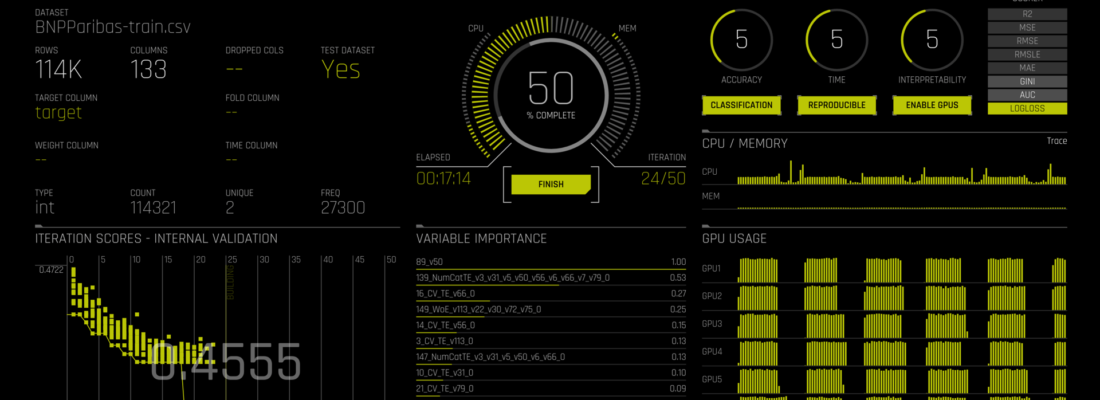New Innovations in Driverless AI


What’s new in Driverless AI
We’re super excited to announce the latest release of H2O Driverless AI . This is a major release with a ton of new features and functionality. Let’s quickly dig into all of that:
Make Your Own AI with Recipes for Every Use Case:
In the last year, Driverless AI introduced time-series and NLP recipes to meet the needs of demanding business. The new bring-your-own-recipe capability ensures data scientists now can quickly customize and extend the Driverless AI to make their own AI with customizations – models, transformers, and scorers, extending the platform to meet any data science requirement. These customized recipes are then treated as first-class citizens in the automatic feature engineering process and eventually creating the winning model. And the most amazing thing about all of this is that customers can explore and consume over 100 open-source recipes , built and curated by the experts and Kaggle Grandmasters at H2O.ai
With recipes, domain experts now have more options to solve their data science problems and to make their own AI by enabling them to address a variety of use cases ranging from credit risk scoring, customer churn prediction, fraud detection, cyber threat prevention, sentiment analysis and more. To learn more about how to use recipes in your experiments, check out this blog here by Parul Pandey. To learn how to build your own recipe, check out this hands-on webinar by Michelle Tanco. If you wish to follow along with a hands-on tutorial instead, then check this out.
Project Workspace
Driverless AI provides a Project Workspace for managing datasets and experiments related to a specific business problem or use case. Whether you are trying to detect fraud or predict user retention, datasets and experiments can be stored and saved in the individual projects. The Leaderboard on the Projects page allows you to easily compare performance and results and identify the best solution for your problem.
As data science practices mature, the need for model management, deployment, and monitoring across enterprises has increased. This involves bringing together different groups in an organization to work together in a seamless fashion to build, review and handoff models for deployment. Project Workspace in Driverless AI enables data scientists to collaborate on different projects, build models and then compare them side by side. To learn more about how to use Project Workspace check out the detailed documentation here .
Model Deployment and Operations
With the new version of Driverless AI, we offer a few extremely convenient options to choose from for deploying ML models, depending on where the AI application is run:
- Directly deployed in a cloud service.
- Configure to run on a local REST server with a couple of clicks.
- A low-latency, standalone MOJO Scoring Pipeline is available for experiments, with both Java and C++ backends (both R & Python wrappers available)
- After an experiment is completed select the deploy option
- Choose the method for deployment
- You model is deployed and will be ready to be tested
In addition, we’re also excited about a new module for Model Admin that enables models that are deployed to be monitored for system health checks and also data science metrics around drift detection, model degradation, A/B testing, and provide alerts for recalibration and retraining.
Explainable AI: Fairness and Bias Checks
With the new version, H2O Driverless AI now has added the ability to perform disparate impact analysis to test for sociological biases in models. This new feature allows users to analyze whether a model produces adverse outcomes for different demographic groups even if those features were not included in the original model. These checks are critical for regulated industries where demographic biases in the data can creep into models causing adverse effects on protected groups.
In addition, the new version has a whole bunch of enhancements to MLI including
- Added ability to run MLI PD/ICE on all features
- Added ability to handle multiple observations for a single time column in MLI Time Series(TS) by taking the mean of the target and prediction where applicable
- Added ability to handle integer time column in MLI TS
Recommendations for columnar transformations in AutoViz
AutoViz now provides recommendations for transformations based on statistical best practices. These are typically columnar transformations to help make the data more suitable for machine learning.
There are, of course, a lot of other enhancements in the product including things like a new R client to access Driverless AI, protobuf-based MOJO scoring runtime libraries for Python, R, and Java (standalone, low-latency), ability to provide max. runtime for experiments. To learn more check out the release notes here.
Also, try out the latest version here by downloading the product here: https://www.h2o.ai/download/ or a free 2-hour test drive on the cloud: https://www.h2o.ai/test-drive/








